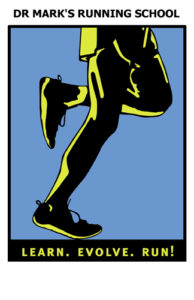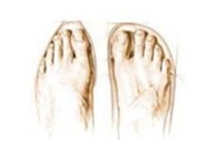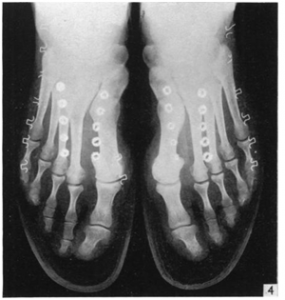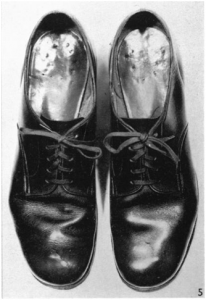 No article on the transition to minimalism is complete without some discussion on the effect of footwear, what is the ideal for footwear, how do you choose what is best for you, and most importantly how to fit the shoe.
No article on the transition to minimalism is complete without some discussion on the effect of footwear, what is the ideal for footwear, how do you choose what is best for you, and most importantly how to fit the shoe.At Two Rivers Treads, we defy old-school thinking of narrow-shaped, ill-fitting conventional shoes. Improper shoe sizing and shape are the primary cause of ingrown toenails, bunions, corns, hammer toes, and hallux valgus. Shoes that don’t fit your feet correctly can also lead to muscular imbalances in the body, leading to foot, knee, and hip injuries.
A proper fit accounts for the natural expansion of the foot upon ground contact. Excess waste is eliminated, along with everything that inhibits your foot’s natural motion. So your foot is free to move and work the way nature intended it to; the way of its own barefoot motion. Toe wiggle freedom.
On sizing…most get it wrong
First, abandon the notion that you have a shoe size. Instead you have a foot size. Shoes are made all over the world and apply different shapes and standards. If you measure your foot seated with a traditional measuring device like a Brannock Device and base your size on that you will likely be off by 1-2 sizes when applied to a running or hiking shoe. One shoe size is only 1/3 an inch.
Also critically important is that the Bannock device measures the widest part of the shoe at the ball. Infant feet and the feet of unshod societies are widest at the ends of the toes, not the ball of the foot. The natural alignment of the human foot is where the metatarsals directly align with phalanges (toes) and get wider than the ball of the foot.
When I look at what is an ideal shoe I base it on what is ideal to complement natural foot function. Let’s assume that the foot is designed to work on its own without the need of modern bracing, cushioning, and motion control technology. One may deviate some from this to compensate for a specific structure or strength issue. The goal is progressive rehabilitation toward the ideal and getting the walker or runner in the least amount of shoe that is safe for them while they work on the functional corrections. To me this is the definition of minimalism.
So what are the four simple features of an ideal shoe:
- Level Heel to Toe (zero-drop) and close to the ground. Our arches are designed to be supported at the ends, and that means heel, ball, and toes in level and balanced contact. This facilitates stability and balance in mid–stance. A shoe should not have “toe –spring” either (picture). This places toes in extension and contributes to extension deformities (hammer toes). Level shoes also complement a proper posture.
- Flexible Last. Your foot naturally bends in all directions as should your shoe. Most shoes are stiff in the middle and stiff where your toes bend at the ball of the foot (MTP joint)
- Wide Toe Box. When the big toe is compressed to be out of alignment, the front end of the arch does not work. The big toe is crtical in balance, stability, and propulsion.
- Not too soft or too thick. The thinner and firmer the shoe the more ground feel (proprioception) you have. The increased ground feel allows your body to adjust to the forces of running in a more efficient way and is optimal for learning natural running form and technique. Without a firm message to the nervous system our body does not know which muscles to use, how hard to turn them on, and how long to keep them on for. To get a clear message in thick/soft shoes we are forced to strike the ground harder and drive the foot onto a firm surface to give us the feedback we require.
Picture: Toebox too narrow. Note deviation of Great Toe
Now onto sizing and here is why most size too small:
- When a load is applied to a foot by running or with a pack weight your foot will spread in length by up to half an inch.
- You need at least an 1/8 inch or more space on heel and toe for any sock.
- You want 1/3 to 1/2 an inch in front of your big toe to allow room for loading and splay
- Your foot will splay 15% in width under load if allowed in the shoe.
- Your foot is widest at the toes and unfortunately most shoes are not shaped this way.
Tips on sizing
Note…We’ve never had a customer return and say their shoes were too big.
- Do not assume you are the same size as a previous shoe.
- Take your time and try several shoes on, preferably at the end of the day. Go run in them. Do not try them on sitting.
- Always try both shoes on. If feet are slightly different size fit the larger foot.
- Take the shoe removable insole out and see how your foot fits against the insole as a template. Is there room at the toes or does your foot spill over the insole? If no room to spare or if your foot spills over, this shoe will not fit comfortably.
- Keep going half size up until the shoes are obviously too big.
- Try on shoes at end of day when feet are most flattened and swollen.
- Try on with the type of sock you will wear for activity.
- For women, you may fit better in a men’s shoe for width at the forefoot.
- Do not lace the shoes up tight. Allow spread in the midfoot and forefoot.
- Go up onto the ball of the foot. Can you put your index finger between your heel and the back of the shoe- if not the shoe is likely too small.
- Consider not using the soft insole. This takes up space in the shoe and interferes with ground feel.
- Walk on a firm surface, not a carpeted one.
- If you are a runner you MUST run in the shoe. What feels nice and soft when walking is the opposite of what you need when running, which is a more firm base to give the message up your kinetic chain to stabilize/balance in mid stance.
- Sandals are great as they allow for natural foot spread without restriction from an upper.
Socks:
- When trying on shoes, wear the socks you would normally wear in them. Socks are not necessary but are mainly for added comfort, especially in avoiding blisters. Like shoes, socks can be too tight, contributing to foot irritation and restriction. For most situations, socks should be thin and not tight. Make sure your socks do not bunch.
- Thicker winter socks may require a half-size larger shoe.
- Which style of socks you wear (low-cut or above the ankle) and what they’re made of (natural fibers such as wool or cotton, or a blend of synthetics) is up to you. But like shoes, make sure they fit well; and be careful to avoid the sock interfering with shoe fit. My preference is merino wool or light synthetic blend.
A few thoughts from my own experience on shoes and safe transitioning:
In the past 3 years I have completely rethought how a shoe should fit, or more accurately I now think about how a shoe should fit rather than just pick a size. Since I started running more true barefoot miles over the last 2 years my foot size has greatly increased in thickness. I can no longer wear any shoe that I owned 2 years ago. To accommodate width, my shoe size has increased from 11.5 to 12.5or 13. I have recycled an entire closet of older work shoes which do not fit and have a heel. It is nice to restart fresh and happy.
We have many customers come in who do not pass any of the functional tests described in Strength and Mobility (link). They have a structural, strength, or mobility issue that does not allow the ideal foot function. We give them specific corrections with exercises they can do all day. If they have the hallux valgus deformity we use Correct Toes. Metatarsal pads are useful for toes held high in extension (hammertoes) as the client works on getting toes down on the floor through the Toe-Yoga exercises.
Does this mean they cannot get into a “minimalist” shoe, absolutely not. Walking and running are two different activities with very different forces. Running has 2.5 times your body weight 1200 steps a mile while balanced on one foot. Walking involves at most 1.1 times your body weight balanced on both feet. This is why it is rare to see a “walking injury”. The foot is more easily rehabbed with walking and standing.
If a runner is strong in single leg stance, have anatomically correct feet, nice flexible heel cords, a good gait already; they are ready to roll pretty quick and do not need much “transition”. They feel great immediately. A young runner needs to transition into modern running shoes in my opinion. This sounds unconventional but imagine the kid playing soccer in flat/flexible shoes or the Kenyan runner being given a pair of running shoes. Do we suggest them to take it slow in these or you may get hurt? Maybe we should and maybe this is why so many high school runners get hurt now as we read stories of runners of years gone by and wonder how they ran without injury.
The opposite is true for someone who fails all these parameters. They need lots of supplemental work and to need to get in proper shoe all day. Be “barefoot” all day. So for walking and standing, which most of us do more than running, get in a thin and most flexible shoe to aid in foot retraining. For the running activity one might still need some assistance in controlling the foot as they progress, so a more protective shoe that still has the 4 key features(above) is ideal.
Remember you goal is fun, play, discovery .
Additional resources:
Five old but essential articles:
- “Athletic Footwear and Running Injuries” by Joseph Froncioni
- “You Walk Wrong” by Adam Sternbergh
- “Why Shoes Make ‘Normal’ Gait Impossible“ by William A. Rossi
- “Take off Your Shoes and Walk” by Simon J. Wikler
- “The Soldiers Foot and the Military Shoe 1912″ by Edward Munson. download pdf on left
A few extras
- great read on transitioning to more minimal shoes read Running Times piece by Brian Metzler.
- A good read by Steve Magness on Footwear
- Natural Running Center Shoe Data Section




Very good insight. Thank you! For me, a size 13 in Xero and Lems gives the proper length fit, with my index finger fitting between the heel and heel cup, however my main metatarsal tendon hurts when wearing this size. No one makes a size 13.5, so I am stuck ordering a size 14 which is huge and leaves much space in the shoe. The width of a 14 is nice, but noticeably too big in length. Suggestions? Just get used to the space and let my foot naturally lengthen? Maybe try a Northsole insole addition to take up some space? Any help is appreciated!